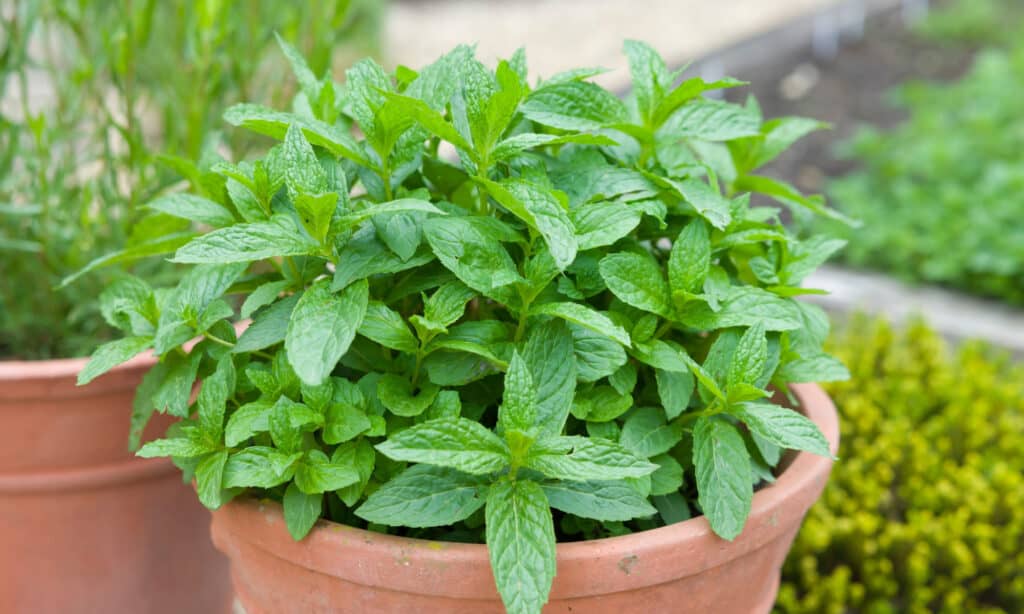Mint is one of the most popular scents and tastes on the planet and it’s all due to the mint plant. From toothpaste to ice cream, tea, and cleaning products, its unmistakable scent makes us all feel refreshed. but why is mint so popular and when you grow it, is mint a perennial or annual?
Let’s find out all about mint.
What Is Mint?

Mint has up to 24 native species.
©Paul Maguire/Shutterstock.com
Mint or mentha is part of the Lamiaceae family, like sage and lavender, and the subfamily Nepetoideae. It’s a large family that still provokes disagreement between botanists attempting to classify the various species.
There are up to 24 native species across the globe including Europe, Australia, and North America. Botanists have cultivated hundreds of extra cultivars.
Mentha prefers wet habitats, but it is persistent and tough, so it will grow in the majority of places. Many mints grow up to 48 inches tall and spread so easily via their roots that they are considered invasive.
In summer, mint has small white flowers called verticillasters atop spikes, but it’s the leaves that mint is best known for. Mint has highly scented aromatic foliage. Leaves can be green, grey, purple, blue, and yellow and often have soft downy hairs on their undersides.
Many gardeners prize mint as a companion plant. The compounds in mint leaves are an excellent environmentally friendly insecticide. Mint can help keep pests away from tomatoes and other summer fruiting vegetables. There are even anecdotal stories of mint repelling mice.
Mint In History
Mint has been used by humans to freshen their breath for centuries! The ancient Greeks believed it made their arms stronger, so they rubbed it across their forearms before battle too. It has also been used across the world as a stomach and headache cure for thousands of years right up to today.
In 2018, the USA produced so much peppermint oil it would have filled an Olympic swimming pool.
But mint has a longer history than the written record. Pliocene-era Mentha pliocenica seeds were found fossilized in modern-day south-eastern Belarus. They are around 5.333 million to 2.58 million years ago.
Is Catmint A Type of Mint?

Catmint is still a type of mint.
©Anna Gratys/Shutterstock.com
Catmint is a member of the nepeta genus that is part of the mint family, so even though catmint doesn’t smell like spearmint or garden mint – it’s still a type of mint! If you look closely you’ll see that catmint stems are square. Square stems are a mint-family giveaway.
Mint: Perennial or Annual?

The mint is perennial.
©Cat Act Art/Shutterstock.com
Mint is a leafy flowering perennial herb. It’s so hardy, that it grows on all continents except Antarctica. It’s one of the few plants with a square stem, and it’s so popular it’s been bred by botanists into a variety of different cultivars and scents.
Perennial mint is simple to grow. This perennial is best grown in a container or it’ll take over a flower bed.
What Does Perennial Mean?
Perennial means a plant that grows back each year. In cold zones, perennial plants often die back to a root ball in order to survive snow and frost. These are called deciduous perennials. Other perennials are evergreen, so they keep some foliage but grow more leaves and flowers the following year.
When a plant dies after one growing season it’s called an ‘annual’. Biennials are plants that take two seasons to complete their lifecycle. They germinate in year one, then flower and seed in year two. Good examples are Sweet Williams and annual wallflowers.
Mint and other plants in the mint family, such as lemon balm, are perennial not annual plants because they grow back each year.
Can Mint Stay Outside Over Winter?
As long as it has well-drained roots, mint is perennial and can stay outside during winter. In warm zones, it will grow all year. In colder zones and northern Europe, it dies back to its roots before re-emerging in early spring.
Some cultivars of mint with a Mediterranean native habitat may not survive a very cold winter. These can be dug up and brought inside or put in a greenhouse for winter.
Should I Let Mint Flower?
This is entirely the gardener’s choice. Flowering mint doesn’t detract from the foliage scent or taste, but the flowers will set seed and might spread around the garden.
One reason to let a mint flower is for the pollinators. Bees and butterflies like mint flowers especially cat mint and water mints.
How To Cut Back Mint
If a mint plant is looking sad in summer, say the leaves are browning, pruning back by a third will rejuvenate them. Cut just above a pair of leaves across the whole plant and water it well.
After a few weeks, you’ll have a new flush of stronger-smelling mint leaves for your tea (or mojito!)
But don’t throw your pruned pile away. If you have long stems, hang them up in a cool, dry place to dry out. Shorter pieces can be spread on a kitchen towel. Once the leaves are completely dry you can store them in a jar ready for winter use.
Is Chocolate Mint Plant Real?
Yes, chocolate mint is real! This cultivar (Mentha × piperita ‘Chocolate Mint’) has brown-purple stems and smells very strongly of chocolate. Beware if you plant it! Although the garden mint scent is said to suppress appetites, chocolate mint does the opposite!
There are many exciting cultivars of mint. Here are some of the most interesting:
- Apple mint (Mentha suaveolens)
- Spearmint (Mentha spicata) – the best for tea!
- Grapefruit mint (Mentha x piperata f. citrata ‘Grapefruit)
- Strawberry mint (Mentha spicata subsp. citrata ‘Strawberry’)
- Moroccan mint (Mentha spicata var. crispa ‘Moroccan’)
- English Lamb (Mentha spicata ‘English Lamb’)
- Water mint (Mentha aquatica)
- Pineapple mint (Mentha suaveolens ‘Variegata’)
How To Grow Mint From Cuttings
Mint is easy to grow and even easier to take cuttings from. Most varieties of mint will develop strong new roots in a glass of water. This is a great science experiment for children and fun for adults too.
Simply cut a piece of new season’s growth above a pair of leaves and place it in a glass of water. Change the water every day to keep things fresh and in less than a week new white roots will appear! You could push the cutting into damp compost and let it grow without the glass of water step if preferred.
Be sure to contain your mint cuttings, even the smallest plant can put out enough roots to colonize the vegetable patch in a year! Remember that mint is a perennial not an annual, so it will come back even if it has disappeared over winter.
Perennial Mint Is A Joy In the Garden
So that’s mint in all its glory. Mint is such a versatile plant. It has a whole host of culinary and medicinal uses that are still practiced today. Next time you drink peppermint tea after a large meal, remember to thank mentha – one of the best scented and tastiest perennial plants we’ve got.
Up Next
The photo featured at the top of this post is © Paul Maguire/Shutterstock.com
Sources
- RHS (1970) rhs.org.uk/herbs/mint/grow-your-own
Thank you for reading! Have some feedback for us? Contact the AZ Animals editorial team.






